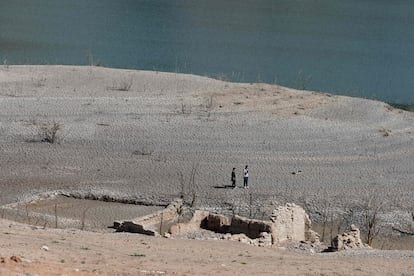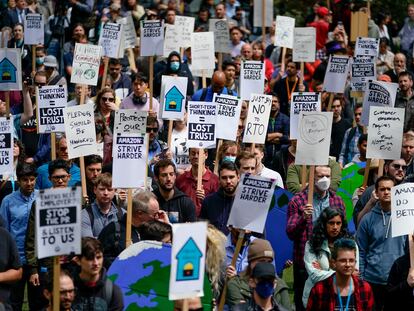Seven of the nine thresholds that allow for human life on earth have already been crossed
A new report quantifies the climatic, natural and pollutant limits that ensure the safe and orderly maintenance of civilization

Back in 2009, a large group of scientists identified nine limits that humans should not cross if they want the earth to remain hospitable to civilization. These included, among others, the availability of fresh water, the conservation of natural areas, pollution levels, the ozone layer and, of course, climate change. Now, a new report just published in the journal Nature quantifies – for the first time – the thresholds for each of these problems that should not be exceeded, in order for the earth’s system to be safe and just, not only for humans today, but for future generations. However, seven of these thresholds have already been crossed in all or in large swaths of the planet. The apocalyptic picture is softened by the fact that the growing hole in the tropospheric ozone layer has fallen from the list: humanity was able to solve the problem in the nick of time.
The 2009 report identified the limits required for the global ecosystem to be sustainable and secure. It was written that, if these limits were to be greatly surpassed, a series of catastrophic changes would follow. But since then, security has been joined by another idea: that the earth’s system will not be secure so long as it is also not fair. The latest report includes this consideration, quantifying the notion of justice between humans, the rest of living beings, as well as future generations.
”Human beings are part of the global ecosystem. We’re a large part of the problem and we have to be a large part of the solution,” summarizes Noelia Zafra, co-author of the work. “But the problems and the solutions don’t affect everyone equally… there are some human beings who bear the inconvenience of sustaining the earth’s system, while others mostly benefit. It also so happens that a few people create problems for many,” Zafra adds. She’s a researcher at BC3: the Basque Center for Climate Change. This is the case, for example, of the emissions that are causing climate change. This increase dates back to the start of the Industrial Revolution: its main protagonists – Europe and North America – are responsible for it. Even now, as emerging countries such as China are beginning to take on a large share of responsibility, half of greenhouse gas emissions come from the richest 10% of the global population. “We will not be able to act together to face the climate and biodiversity crisis if we don’t all start from the same situation and if there’s conflict between us,” Zafra adds.
“It is not a goal, it is a limit”
To curb climate change, the 2015 Paris Agreement set the acceptable increase in global average temperature at 1.5 degrees. But the need for justice explains why the authors of the recent report have further reduced the limit of extra warming that the planet could support, lowering it to one degree. Johan Rockström – director of the Potsdam Institute for Climate Impact Research (Germany) – said in an online press conference that “1.5 degrees isn’t an objective, it’s not a goal – it’s a physical limit.” If we pass that cap, the risks are very high, but even before exceeding it, global warming is generating significant consequences. Scientists estimate that the temperature has already risen by an average of 1.2 degrees. The impact can be felt across most of the planet, with millions of people suffering as a result.
“Human beings are part of the global ecosystem. We’re a large part of the problem and we have to be a large part of the solution”Noelia Zafra, a researcher with BC3
One of the contributions of this report is that it doesn’t stop at the climate emergency. For the authors, it’s already evident that climate change isn’t the only existential threat facing human civilization. Another of the quantified thresholds is the one that has to do with the portion of the planet that still preserves its original state. The Earth Commission – a global alliance formed by leading scientists – states that 50% and 60% of the planet’s land surface area be kept free of livestock, agriculture, mining or any other human interference. “Currently, we’re [at a level of] between 45% and 50%. So, just below the limit,” notes David Obura, a co-author of the study from Coastal Oceans Research and Development. Obura also points out that deforested areas of the planet can still bolster the ecosystem’s resilience. Millions of hectares dedicated to grazing and crops – as well as cities – can be part of the solution, provided that for every square kilometer of ecosystem altered, a minimum of 20% has vegetation, even if it’s planted by humans.
Another one of the thresholds quantified (and already exceeded) involves the extra nutrients contributed to the earth by humans. The scientists particularly quantify anthropogenic nitrogen and phosphorus, which are primarily used in agriculture. An excess of these elements alters both the substrate and the water, in a process known as eutrophication. The limits not yet exceeded globally – but certainly exceeded in large swaths of the planet – have to do with the use of water, both on the surface and underground. According to the report, a third of the planet is already experiencing an excess extraction of surface water resources, the limit of which has been set at 20%. For groundwater, the replenishment rate is not respected across half the earth. Meanwhile, regarding air pollution caused by the emission of particles of non-natural origin – coming from processes such as engine combustion, heating and cooling, or industrial emission – the limit is still far from being exceeded on a global scale. However, it has already been exceeded in various regions of the planet, such as Southeast Asia.
“Fresh water, air, pollutants such as nitrogen and phosphorous, the integrity of the biosphere provide resilience and stability to the entire Earth system”Johan Rockström, director of the Potsdam Institute for Climate Impact Research (Germany)
The report acknowledges that it leaves out problems such as ocean acidification, the accumulation of plastic and microplastics, persistent chemicals, or antibiotics. The authors maintain that these are threats that have not yet been sufficiently studied to determine if they pose existential risks. Several of the problems are also interlinked, such as the loss of biodiversity accelerated by excess nutrients. And others – such as climate change – exacerbate the severity of the others.
”If we study fresh water, air, pollutants – such as nitrogen and phosphorous – or the integrity of the biosphere – both in terms of surface area and biodiversity – we do this because, if [these factors] add up, they provide resilience, buffering capacity and stability to the entire global ecosystem,” Rockström said at the press conference. Crossing each threshold in these areas reduces “the strength of the planet to face the climate crisis.”
”Seven of the nine indicators that we’ve been evaluating are outside the fair and safe space. We can also see that there’s a window [of opportunity], meaning that a transformation that recovers said safe space is still possible. But it requires transformations and very, very rapid action. And it will not be enough to simply decarbonize the global energy system.”How to do it? Zafra, from BC3, discusses what this challenge entails: “Human well-being cannot exist without the earth’s system. Reconciling the well-being of all people fairly within the limits of the [global ecosystem] involves asking ourselves what well-being really is: what and how much we need to feel good, how much we are willing to harm other people and living beings to achieve [our goals]... we need to carry out broad social processes at all scales that allow for inclusive and just transformations to tackle the climate and biodiversity crisis.”
Sign up for our weekly newsletter to get more English-language news coverage from EL PAÍS USA Edition
Tu suscripción se está usando en otro dispositivo
¿Quieres añadir otro usuario a tu suscripción?
Si continúas leyendo en este dispositivo, no se podrá leer en el otro.
FlechaTu suscripción se está usando en otro dispositivo y solo puedes acceder a EL PAÍS desde un dispositivo a la vez.
Si quieres compartir tu cuenta, cambia tu suscripción a la modalidad Premium, así podrás añadir otro usuario. Cada uno accederá con su propia cuenta de email, lo que os permitirá personalizar vuestra experiencia en EL PAÍS.
¿Tienes una suscripción de empresa? Accede aquí para contratar más cuentas.
En el caso de no saber quién está usando tu cuenta, te recomendamos cambiar tu contraseña aquí.
Si decides continuar compartiendo tu cuenta, este mensaje se mostrará en tu dispositivo y en el de la otra persona que está usando tu cuenta de forma indefinida, afectando a tu experiencia de lectura. Puedes consultar aquí los términos y condiciones de la suscripción digital.
More information
Últimas noticias
‘How does it feel to be a failure?’: Elizabeth Berkley’s journey from ‘Showgirls’ ridicule to vindication
The story of the Málaga virus: The code that haunted Google’s cybersecurity center director for 30 years
The impact of Ecuador’s mega-prison: A polluted river, cleared forests and military checkpoints
Corinne Low: ‘I’m more concerned about the female happiness gap than the gender wage gap’
Most viewed
- The low-cost creative revolution: How technology is making art accessible to everyone
- Christian Louboutin: ‘Young people don’t want to be like their parents. And if their parents wear sneakers, they’re going to look for something else’
- All the effects of gentrification in one corner of Mexico’s Colonia Roma
- Liset Menéndez de la Prida, neuroscientist: ‘It’s not normal to constantly seek pleasure; it’s important to be bored, to be calm’
- Christmas loses its festive spirit: ICE fears cast shadow over religious celebrations











































